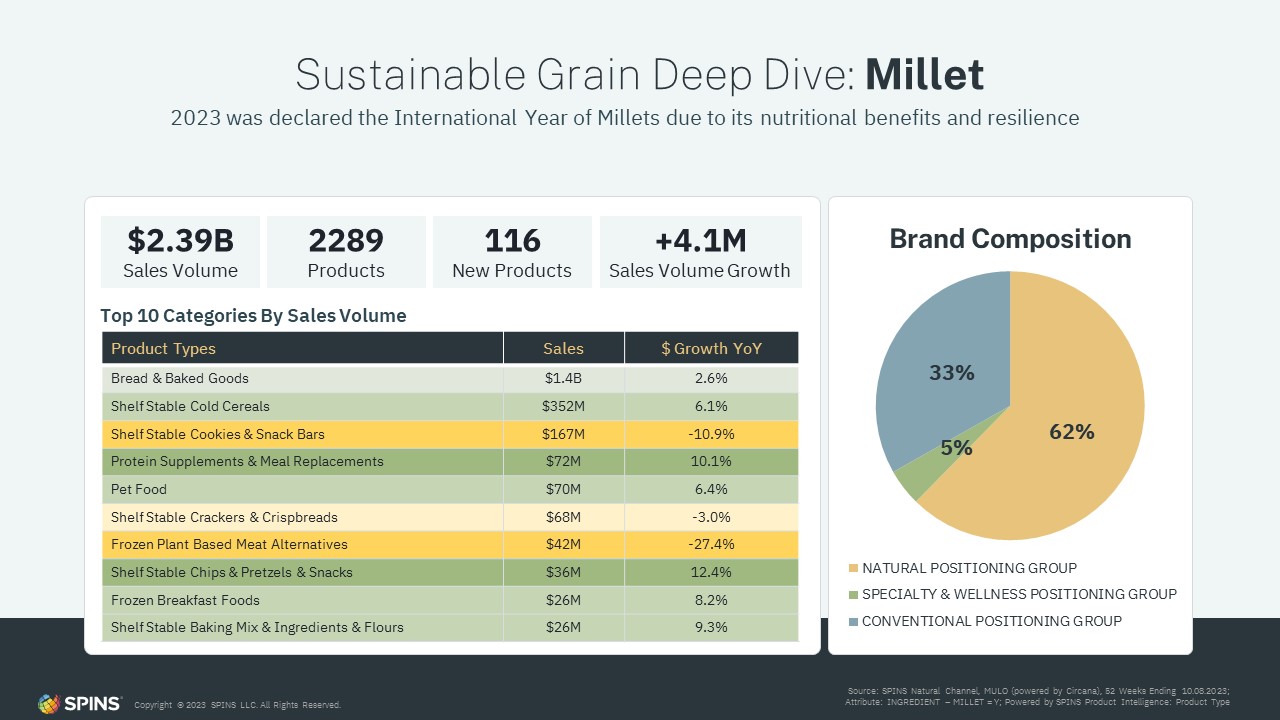Key Takeaways
- Sustainable grains provide more environmentally friendly alternatives to traditional ones
- Not only do many provide high yields, but they are also as or even more nutritious than traditional counterparts
- Look out for millet as a rising star of the sustainable grain world
Grains are a key part of the human diet and are essential to providing nutrients and energy throughout the day. They’re found throughout the grocery store and are a primary source of fiber, carbs, protein, antioxidants, and overall, a crucial part of a balanced diet! In this post we’ll dive deeper into sustainable grains—grains that are alternatives to traditional grains such as wheat, barley, oats, and rye.
What are Sustainable Grains?
Sustainable grains are frequently native to harsh growing climates which have allowed them to become highly resilient and adaptable to conditions like drought or pests! Similar to super mushrooms, there are a wide variety of sustainable grains, each with different benefits related to nutrition or environmental impact.
Some of the most common sustainable grains include:
- Amaranth: Pest and drought-resistant Mesoamerican grain that grows quickly. Naturally anti-inflammatory and low cholesterol.
- Buckwheat: Gluten-free East Asian grain adapted to high altitudes and variable climates. Has a short growing season and returns nutrients to the soil.
- Farro: Now an Italian staple, this ancient grain is originally from the Middle East. Not only drought and pest-resistant but also fast-growing and high-yield.
- Millet: Found across Asia and Africa, well known sustainable grain with the highest calcium content of cereal grains.
- Quinoa: Native to the Andes Mountains, extremely nutritious, and adapted to high-altitude, dry environments.
- Sorghum: Mineral-rich, drought and pest-resistant East African grain frequently used for gluten-free bread.
- Teff: Nutritionally dense Ethiopian grain with super high yields—one pound of seeds can produce an entire acre of crops.
Why Sustainable Grains Matter
As shoppers increasingly buy based on their values, attention to these grains will only increase as they nourish not only people but also the planet. They provide a diverse array of benefits to the planet due to their high yields, quick growth cycles, and resilience and adaptability. Depending on the grain, they can return nutrients to the earth, reduce soil degradation and erosion, and even act as effective means to capture and store atmospheric carbon dioxide!
But these grains aren’t just good for the planet, they’re good for people too. Grains like quinoa have long been called a superfood. Several of these sustainable grains are nutritionally dense and are great sources of protein, iron, fiber, and several other vitamins and minerals! Many are also gluten-free and are fantastic options for those with specific dietary needs.
Further, it’s important to note that these grains are likely already more common than you think. While they may not always be the predominant grain, they’re frequently used in breads, snacks, granolas, and even pet food!
Sustainable Grain Deep Dive: Millet
The United Nations and Food and Agriculture Organization (FAO) declared 2023 the International Year of Millets to raise awareness of the nutritious and resilient crop! Per the FAO, millet’s health benefits and suitability for cultivation under adverse and changing climate conditions were a large reason it was deserving of the spotlight. This additional attention means that millet is well-positioned for a breakout.
That said, millet is not new to the market and, while not as visible as other grains, has an established presence across a wide variety of products and categories.

Source: SPINS Natural Channel, MULO (powered by Circana), 52 Weeks Ending 10.08.2023; Attribute: INGREDIENT – MILLET = Y; Powered by SPINS Product Intelligence: Product Type
Even though it often flies under the radar, sales for products incorporating millet peaked at $2.39 billion over the past year. Unsurprising considering there are thousands of products that already use millet, and we’ve seen over a hundred new products enter this year alone.
As we dig into the data, we see that while millet is commonly used as a key part of healthy multigrain formulations in cereals and snacks, it’s also popular in plant-based protein products. This capitalizes on the existing shopper trend of nutritious, climate- and eco-friendly products. But this movement isn’t limited to what shoppers themselves are consuming—it also extends to their furry friends with pet food being another major category for millet.
Shifting the focus to the brand composition of millet products, over 62% of millet products come from the natural positioning group compared to only 33% from conventional. Millet has definitely caught the attention of natural brands striving to implement a better-for-you and better-for-the-planet ingredient formula, and shoppers have caught on: USDA Certified Organic (95%+) millet products are growing at 5% as compared to -0.6% for products that are not. This reinforces how important well-rounded ingredient profiles that promote sustainability drive sales and highlight the opportunity for the rest of the market.
As the year of millet sunsets, the renewed attention and high profile this grain received in 2023 will surely help drive sales well into the future.
Conclusion
Sustainable grains tick multiple boxes for shoppers who are looking for eco-friendly, nutritious products. With such a wide array of options available, as these grains continue to move into the spotlight across categories and aisles, any shopper is sure to find one that meets their tastes.





